Red dot sights are becoming more popular with hunters and target shooters. These red dot optical sights seem mysterious to some shooters. They wonder exactly how that red dot is created in the optic. It seems amazing that the red dot in the optic is always on target no matter where your head is positioned. Many wonder how does a reflex sight work.
A reflex sight is a type of red dot sight. The red dot is generated by a very-energy efficient LED light and onto a concave semi-transparent lens. The lens allows the shooter to clearly see the red dot and the target. The red dot appears on the target at the correct spot regardless of the position of the shooter’s eye.
This is a very short and less than the technical description of how a reflex sight works. There are several different configurations of lens and mirror configurations. Different reticle images are available from different manufacturers. You can also find reflex sights that look like a traditional tube riflescope or open hooded styles. Understanding what you are looking at and what to look for is key to deciding on a reflex sight.
When was the Reflex Sight Invented?
Many shooters have the impression that reflex sights are a relatively recent invention. On the contrary, the history of reflex sights traces back to 1900 when optical designer and telescope maker Howard Grubb received Patent NO. 12108.
Interest in this new type of sight was immediate. The German AirForce used reflex sights on fighter aircraft as early as 1918. By 1930, many countries adopted a form of the reflex sight for anti-aircraft guns, naval guns, anti-tank weapons. The refinement and development of reflex style sights continued through World War Two and the small, compact, and lightweight optical sights we use today.
So, that laser-based reflector red dot sight that you want to mount on your rifle has a long history. Many people think the optical sights are upgraded and updated technologies from a century ago. Howard Grubb would be amazed at the changes a hundred years have produced, but he would undoubtedly recognize his work and ideas in these modern adaptations.
What are the Types of Reflex Sights?
Technology has brought us a long way. The original reflex sights created early in the 20th century were often cumbersome and large devices requiring large power sources to create the virtual red dot image. This made them adaptable only to airplanes or larger guns and artillery. However, the advent of LED and laser technology spawned the development of reflex sights for the non-military markets.
Reflex sights have evolved considerably in the last 30 years. Today, many manufacturers offer reflex sights in several configurations. The two types most often purchased by shooters are the tube-style reflex sight and the open hooded style.
Open-Style Hooded Reflex Sights
The current design of open-style hooded reflex sights shares many similarities with the first reflex sights used on aircraft during World War One. There is no traditional tube to house the reflector or light source, allowing for open-style reflex sights to be very small and lightweight. Many open-style hooded reflex sights are small enough to be mounted on handguns easily.
Open-style reflex sights are also undergoing some technological change. With the advent of high-efficiency LED lights and small laser emitting devices, even open-style reflex sights are changing rapidly. Some manufacturers are now encapsulating their reflex sights into small compact enclosures to protect the glass and light sources.
Tube-Style Reflex Sights
If you prefer the look and feel of a traditional optical scope, you can still have the functionality of a reflex sight. Many riflescope manufacturers are building reflex sights into traditional tube-style housings. These tube-style reflex sights use the same mounting systems as traditional optical scopes and often have the same style of turret adjustments.
Many of these tube-style reflex sights are labeled “tactical” style scopes. Many shooters believe that the tube housing offers better protection of the reflex riflescope than an open housing or even a hybrid enclosed hooded reflex sight.
Do I Use a Reflex Sight Like a Traditional Optical Riflescope?
Using a reflex sight is different than shooting with a traditional optical riflescope. Traditional riflescopes are almost always used by closing your non-dominant eye. The image you see in the scope includes your target and the reticle in your scope. This makes you dependent on the riflescope’s field of view for the image you see.
The accepted practice of shooting with a reflex sight is to shoot with both eyes open. With practice, you can learn to see the reticle or dot in the reflex sight, your target, and much of the surrounding area. The effect of having both eyes open is a more natural view downrange.
Learning to use a reflex sight properly takes some training and practice. However, most shooters find that they eventually train their eyes and brains to the new techniques. Shooting with both eyes open becomes a natural and instinctive method of shooting.
Are Reflex Sights Magnified?
In general, reflex sights do not include magnification. Reflex sights are designed for dynamic targeting based on shooting with both eyes open. In addition, red dot sights are not typically used for long-range shooting. This makes reflex sights a great choice for short to medium range distances of up to 150 yards. Law enforcement and military shooters rely on reflex sights for encounters in confined spaces where quick and accurate sight acquisition is critical.
However, you may be able to add a separate magnifier behind your reflex sight if a low level of magnification is desired. These separate magnifier units usually offer 3X magnification, and many are designed to quickly flip to the side to give you a clear field of view without magnification.
Are all Red Dot Sights Reflex Sights?
Not all red dot sights are reflex sights. Technically, a red dot sight is a reflex sight system enclosed in a traditional style of riflescope tube. The differences between the two are subtle but should be noted for how they can affect your shooting or hunting.
Many shooters believe that a tube-style red dot sight is more accurate than an open-style reflex sight. There is also evidence that a tube-style red dot sight is more robust than an open-style hooded reflex sight.
Is there a Difference between Laser and LED Light Sources?
Reflex sights that use a laser to generate the red dot or reticle tend to be much sharper than those that employ LED technology. Laser-based reflex sights generally have a straight front lens. A prism is used to split the laser light into many smaller points shaped into a point on the front lens. High-quality prisms are expensive and add to the cost of the reflex sight.
LED technology is cheaper, and the light point is technically easier to produce. However, the semi-conductor mirrors and curved semi-transparent lenses can make the red dot appear less sharp and bright. LED-based reflex sights are, however, less expensive.
What are the Advantages of a Reflex Sight?
Reflex sights are popular with many shooters. There are several advantages to mounting a reflex sight on your rifle or pistol. In many cases, a reflex sight can replace a traditional optical sight with great results. Understanding when and where reflex sights work best is critical in deciding on the best reflex sight for your firearm.
The Weight and Size Difference
Reflex sights are, by nature, lighter and smaller than traditional optical sights. Adding weight to a rifle or pistol is always a tricky consideration. Additional weight can change a rifle or pistol’s balance and shooting characteristics. Traditional optical rifle scopes can also be bulky, making the rifle cumbersome to carry and transport.
Many shooters appreciate the smaller size of most reflex sights and the reduction in weight on their rifle or pistol. This can be especially true if your shooting or hunting style requires quick target acquisition or long treks over difficult terrain to get to your targets.
Faster Target Acquisition
As discussed, learning to shoot a reflex sight requires having both eyes open. This can allow faster target acquisition by increasing your effective field of view. Using your peripheral vision and your direct line vision makes it easier to track and acquire moving targets. Once the necessary skills are learned, many shooters report that they find tracking and aiming at moving targets much easier.
No Parallax Errors
Reflex sights typically aren’t magnified. The lack of magnification eliminates parallax errors in the scope and reticle. This also eliminates the need for complex and bulky mechanisms in the scope to allow corrections for parallax errors. For many shooters, simpler is better when it comes to a riflescope
Unlimited Eye Relief
The design of most reflex sights provides almost unlimited eye relief for the shooter. This is one reason that reflex sights have become so popular on handguns. Technology has improved the size and weight of the reflex sight is to a minimum. With no limit on the required eye relief, reflex sights allow pistol shooters a much-improved sight picture than traditional optical scopes.
Sight and Head Alignment
Traditional optical scopes and iron sights are dependent on the head and eye placement for accuracy. Head placement on the stock with the scope can seriously affect your aim with traditional rifle scopes. Reflex sights eliminate many of these problems. Since the red dot is the only aiming point on the sight, the red dot tends to stay in the correct reference point no matter where your eye is placed. If you change the angle of your head or eye, the red dot retains its position in reference to the target.
How About the Disadvantages of a Reflex Sight?
There are disadvantages to using a reflex sight. Many of these disadvantages are related to how reflex sights are designed to be used by the shooter. Some are related to the technology employed in red dot sights. No system is perfect, and you should understand the disadvantages of a reflex sight before making any decisions.
Reflex Sights Are Battery Dependent
Without a power source, reflex sights are useless. If the battery runs down in the field, it must be replaced before you can use the reflex sight. Traditional optical scopes with illuminated reticles don’t suffer from this shortcoming. Even if the battery fails, the reticle remains visible even though it is no longer illuminated.
This can be an irritation or a major problem depending on the reflex sight you choose. Some reflex sights require removing the sight from your rifle to change the battery. Others have top loading or side loading batteries, making battery changes much easier.
Environmental Issues Can Be a Problem
If you opt for an open-style reflex sight, environmental conditions can produce problems. Since the viewing lens is open to the air, this type of reflex sight is prone to more easily fogging under certain conditions. This can be particularly troublesome for pistol shooters who mount reflex sights. Keeping a concealed carry pistol close to your body keeps it warm. Deploying the pistol rapidly into a cold or moist environment can leave the reflex sight virtually useless when it fogs over.
For this reason, many shooters choose to mount an enclosed reflex sight. The trade-off of slightly more bulk and weight may be worth knowing that the reflex sight will be visible in a greater range of environmental conditions.
The Lack of Magnification is a Consideration
Most reflex sights aren’t magnified. Without magnification, the distance at which a reflex sight is useful is limited. For the most part, reflex sights should be kept to distances under 150 yards. For many who hunt In North America, this can limit the usefulness of a reflex sight in the field.
Many hunters solve this problem by adding a magnifier to their rifles. Magnifiers typically mount behind the reflex sight and magnify the image in the field of view. Most magnifiers are equipped with flip to the side mounts that allow the shooter to use the reflex sight without magnification when necessary.
Adopting a Different Way of Aiming Can Challenge Some Shooters
Reflex sights are designed to be used with both eyes open when aiming. Many shooters find this a difficult change from their traditional aiming techniques. Changing your aiming technique is not required. However, if you choose to maintain your traditional one eye aiming method with a reflex scope, you will lose many advantages that a reflex scope offers.
Reflex Sights – An Old and New Technology
Contrary to what many people think, reflex sights are not new technology. This sight style has been in use for more than one hundred years with great success. However, new technologies have brought the reflex sight into the 21st century. These versatile sights are smaller, more powerful, and more adaptable than ever.






![Surviving In Your Vehicle [PODCAST]](https://survivalcove.com/wp-content/themes/mts_sociallyviral/images/nothumb-sociallyviral-featured.png)

![Bug-Out Medicine | Dr. Bones & Nurse Amy [PODCAST] Bug-Out Medicine | Dr. Bones & Nurse Amy [PODCAST]](https://survivalcove.com/wp-content/uploads/2022/03/Modern-Combat-and-Survival-Podcast-370x297.jpg)



















